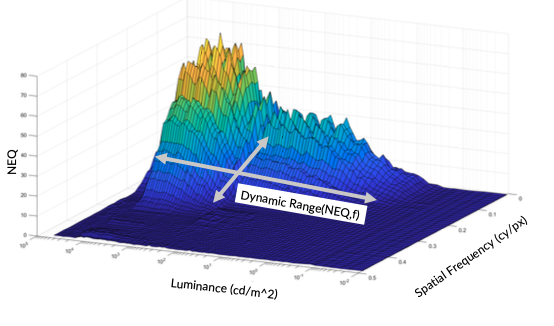
This paper investigates the application of Noise Equivalent Quanta (NEQ) as a comprehensive metric for assessing dynamic range in imaging systems. Building on previous work that demonstrated NEQ’s utility in characterizing noise and resolution trade-offs in imaging systems using the Dead Leaves technique, this study seeks to validate the use of NEQ for dynamic range characterization, especially in high-dynamic-range (HDR) systems where conventional metrics may fall short. This paper makes use of previous work that showed the possibility to measure noise and NEQ on the dead leaves pattern which is otherwise typically used for the measurement of the loss of low contrast fine details, also called texture loss. This shall now be used to improve the measurement of the dynamic range.

The dead leaves pattern is very useful to obtain an SFR from a stochastic pattern and can be used to measure texture loss due to noise reduction or compression in images and video streams. In this paper, we present results from experiments that use the pattern and different analysis approaches to measure the dynamic range of a camera system as well as to describe the dependency of the SFR on object contrast and light intensity. The results can be used to improve the understanding of the performance of modern camera systems. These systems work adaptively and are scene aware but are not well described by standard image quality metrics.

Nonlinear CMOS image sensor (CIS) technology is capable of high/wide dynamic range imaging at high frame rates without motion artifacts. However, unlike with linear CIS technology, there is no generic method for colour correction of nonlinear CIS technology. Instead, there are specific methods for specific nonlinear responses, e.g., the logarithmic response, that are based on legacy models. Inspired by recent work on generic methods for fixed pattern noise and photometric correction of nonlinear sensors, which depend only on a reasonable assumption of monotonicity, this paper proposes and validates a generic method for colour correction of nonlinear sensors. The method is composed of a nonlinear colour correction, which employs cubic Hermite splines, followed by a linear colour correction. Calibration with a colour chart is required to estimate the relevant parameters. The proposed method is validated, through simulation, using a combination of experimental data, from a monochromatic logarithmic CIS, and spectral data, reported in the literature, of actual colour filter arrays and target colour patches.